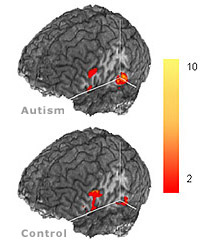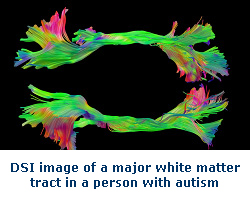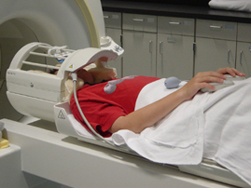Projects
fMRI and Cognitive Studies in Autism
 The CCBI is part of the NIH (Autism Center of Excellence) project to examine the cognitive and brain activity characteristics of high-functioning people who have autism.
The CCBI is part of the NIH (Autism Center of Excellence) project to examine the cognitive and brain activity characteristics of high-functioning people who have autism.
Videos featuring participants with autism and investigators associated with our autism studies.
The CCBI autism project encompasses a large set of functional and structural MRI studies in people with autism. While the functional imaging studies examine the neural basis of higher cognitive and social functions in autism, the structural studies explore the abnormalities in white matter structures. Recent studies from the lab have found reduced synchronization and coordination among brain regions in people with autism. A study on executive functioning using the Tower of London task found that the frontal and parietal regions are underconnected in people with autism relative to control participants (Just et al., 2007). Another study examined the neural basis of processing imagery in sentences and found that people with autism generate visuospatial imagery while comprehending language whether it is required or not (Kana et al., 2006). Yet another study on response inhibition found atypical activation and functional connectivity in participants with autism (Kana et al., 2007). These studies and many others, all of which target higher cognitive functions, have found frontal-parietal underconnectivity in people with autism. This is striking considering the involvement of these regions in higher cognitive functions.
Functional underconnectivity in autism is not limited to cognitive functions. We also found underconnectivity in autism during the resting state, i.e., while the participants are not doing any task (Cherkassky et al., 2006).
 Diffusion Imaging of White Matter: We are using modern diffusion imaging techniques, such as diffusion spectrum imaging (DSI), to examine the structural integrity of white matter in people with autism and typical participants. These imaging techniques visualize axonal tracts by measuring the diffusion of water along white matter fibers. Our first study found an abnormal developmental trajectory in people with autism (Keller et al., 2007). Current studies are using high-definition fiber tractography (HDFT) to provide a more complete account of the reduced anatomical connectivity in autism. Findings of these functional and structural studies indicate widespread neural connectivity abnormalities in people with autism.
Diffusion Imaging of White Matter: We are using modern diffusion imaging techniques, such as diffusion spectrum imaging (DSI), to examine the structural integrity of white matter in people with autism and typical participants. These imaging techniques visualize axonal tracts by measuring the diffusion of water along white matter fibers. Our first study found an abnormal developmental trajectory in people with autism (Keller et al., 2007). Current studies are using high-definition fiber tractography (HDFT) to provide a more complete account of the reduced anatomical connectivity in autism. Findings of these functional and structural studies indicate widespread neural connectivity abnormalities in people with autism.
Our ongoing studies investigate the underconnectivity theory of autism focusing on four different cognitive areas: language comprehension, visuospatial processing, social cognition, and executive functioning. In addition, we are investigating differences in inter-regional white matter tracts to supplement the functional data.
Language Comprehension: One branch of our autism research has revealed systematic differences in participants with high-functioning autism in the activation and coordination of the distributed language network during sentence comprehension (Just et al., 2004; Kana et al., 2006). In these studies, the activation in the language network was distributed differently than in neurotypical participants, and the synchronization among the activated areas was lower among the participants with autism. Other studies have explored the ability of individuals with high-functioning autism to process inferences during narrative comprehension (Mason et al., 2008), as well as the ability to comprehend irony.
 Visuospatial Processing: Another set of our studies examines brain activation patterns in autism during visuospatial and working memory tasks. One study found that individuals with autism recruit visual imagery processing for sentences requiring imagery, but also for sentences that do not (Kana et al., 2006). Another study found decreased frontal activation and increased visuospatial activation (relative to neurotypical participants) during the performance of an embedded figures task (Damarla et al., 2010). We have also found atypical activation in participants with autism during an inhibition task (Kana et al., 2007) and n-back tasks that required letters or faces to be maintained, updated, and compared in working memory (Koshino, et al., 2005, 2008).
Visuospatial Processing: Another set of our studies examines brain activation patterns in autism during visuospatial and working memory tasks. One study found that individuals with autism recruit visual imagery processing for sentences requiring imagery, but also for sentences that do not (Kana et al., 2006). Another study found decreased frontal activation and increased visuospatial activation (relative to neurotypical participants) during the performance of an embedded figures task (Damarla et al., 2010). We have also found atypical activation in participants with autism during an inhibition task (Kana et al., 2007) and n-back tasks that required letters or faces to be maintained, updated, and compared in working memory (Koshino, et al., 2005, 2008).
Social Cognition: A newer set of studies has investigated the activation patterns associated with atypical social processing in autism. One study found that the autism participants recruited Theory of Mind processing during narrative comprehension even for stories which did not have a social component (Mason et al., 2008). Another study found a decreased response in frontal Theory of Mind areas in participants with autism as they attributed mental states to the interactions of animated geometric figures (Kana et al., 2009). Current work is exploring the brain activation and synchronization as participants with autism learn to detect lies told by computer-animated avatars. These studies aim to characterize the neural correlates of the atypical social processing that is one of the diagnostic features of autism.
Executive Functioning: A fourth set of imaging studies investigates the performance of individuals with autism when they are performing tasks that require executive functioning. One study showed an atypical pattern of activation and decreased synchronization while participants with autism performed a Tower of London task (Just et al., 2007). Another project is examining the brain activation while participants with autism perform two tasks simultaneously. The goal of these studies is to determine how multitasking affects the communication and collaboration among brain areas.
Our studies test the theory that the cognitive deficits that autistic individuals exhibit in tasks that require the coordination or integration of several brain regions are due in large part to an underconnectivity among brain areas. The converging evidence from a variety of tasks is expected to produce a characterization of autism that will provide new insights for therapy and for facilitating daily functioning.
Participation in the autism project
We are interested in recruiting autistic patients to participate in our project. The eligibility requirements are:
 - Age 5 through 65.
- Age 5 through 65.
- An IQ of 80 or higher.
- Satisfy research diagnostic criteria.
- Show no evidence of fragile-X, tuberous sclerosis, or other known causes of autism.
- Be verbal and speak in sentences.
- Be able to complete the neuropsychological tests and brain imaging studies.
We will be able to provide compensation to the participants.
- Participants receive compensation for their time, and may be able to participate in multiple studies.
- Participants are also compensated for their travel and overnight accomodations.
- In addition, participants will receive a 'gold standard' diagnostic and neuropsychological evaluation (including IQ) at no charge.
Please contact the autism recruiter (autismrecruiter@upmc.edu) if you know of potential candidates or visit the Autism Research Program's web site.
Click here for an interesting blog post describing the experiences of a previous participant.
